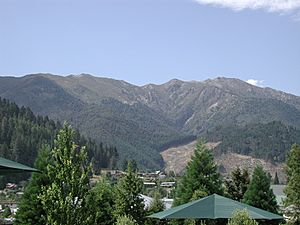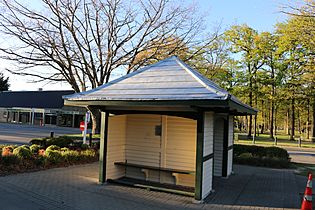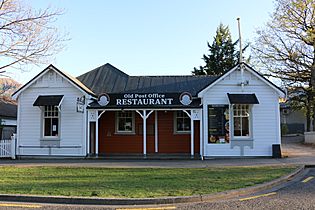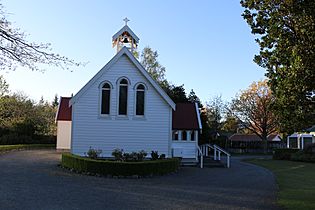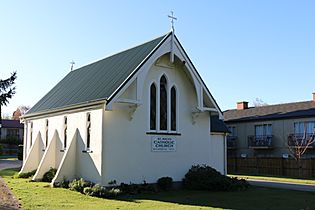Hanmer Springs facts for kids
Quick facts for kids
Hanmer Springs
|
|
|---|---|
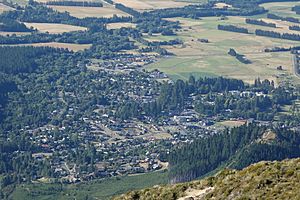
Hanmer Springs from Mount Isobel
|
|
| Country | New Zealand |
| Region | Canterbury |
| District | Hurunui |
| Community board | Hanmer Springs Community Board |
| Ward | West Ward |
| Electorates |
|
| Area | |
| • Total | 4.01 km2 (1.55 sq mi) |
| Elevation
(NZHR, Airport)
|
338 m (1,109 ft) |
| Population
(June 2023)
|
|
| • Total | 1,140 |
| • Density | 284.3/km2 (736/sq mi) |
| Postcode |
7334
|
Hanmer Springs is a small and popular town in the Canterbury area of New Zealand's South Island. It is famous for its natural hot springs. The local Māori name for Hanmer Springs is Te Whakatakanga o te Ngārahu o te ahi a Tamatea. This means “where the ashes of Tamatea’s fire lay.” Tamatea was a captain of the Tākitimu canoe.
Hanmer Springs is about 130 kilometres (80 miles) north-west of Christchurch. It is also 65 kilometres (40 miles) south-west of Kaikōura. The town is in the Hurunui District. It sits at the base of Conical Hill. The larger Mount Isobel, which is 1324 metres (4344 feet) high, overlooks the town.
Contents
- What's in a Name?
- A Glimpse into Hanmer's Past
- Who Lives in Hanmer Springs?
- Weather in Hanmer Springs
- Relaxing at the Hot Pools
- Fun Things to Do in Hanmer Springs
- Exploring Hanmer Springs Forest
- How Hanmer Springs Works
- Getting Around Hanmer Springs
- Skiing Adventures
- Mountain Biking Trails
- Famous Buildings in Hanmer Springs
- Learning in Hanmer Springs
- Animals of Hanmer Springs
- How Hanmer Springs is Governed
What's in a Name?
Hanmer Springs is named after Thomas Hanmer. He owned a large farm called Hawkeswood Station in the 1850s. Thomas Hanmer was born in Hanmer, Wales. He came to New Zealand in 1852. He was looking for good land for farming. He joined a group of surveyors in the Amuri District. During this time, his name became linked with the hot springs. He never actually lived in Hanmer Springs. There is a statue of Thomas Hanmer in the middle of the town.
A Glimpse into Hanmer's Past
The hot springs were first found by William Jones in early 1859. A bridge was built over the Waiau Uwha River in 1864. This bridge made it easier to reach the area. However, it only lasted ten years before a strong wind blew it down.
In 1879, surveyor John Turnbull Thomson mapped out the land for the town. The hot springs were not part of this mapped area at first. They were still in their natural state. Only steps and a changing shed were available. In 1882, people in the New Zealand government talked about developing the town. They wanted to make sure the public could always use the springs.
Construction of a bath house began in 1884. A new bridge was opened in 1887. This bridge still gives access to Hanmer Springs today. It is a very important historical structure. The government invested a lot of money into Hanmer Springs. This helped it become a popular resort.
Who Lives in Hanmer Springs?
Hanmer Springs is a rural settlement. It covers about 4 square kilometres (1.5 square miles). The town has grown over the years. In 2018, about 960 people lived here. This was an increase from earlier years.
The people living in Hanmer Springs come from different backgrounds. Most residents are of European descent. There are also people of Māori, Asian, and other ethnicities. Many people who live here were born overseas. This makes Hanmer Springs a diverse community.
Weather in Hanmer Springs
Hanmer Springs has different temperatures throughout the year. In summer, during January and February, the average high is 22 degrees Celsius (72°F). The average low is 9 degrees Celsius (48°F). Sometimes, summer temperatures can even go above 35 degrees Celsius (95°F).
In winter, during July, the average high is 9 degrees Celsius (48°F). The average low is 1 degree Celsius (34°F). Snow often falls in winter. Sometimes, heavy snow can close the road into Hanmer Springs. July also has the most rainfall on average. January has the least.
Relaxing at the Hot Pools
The hot pools are the main attraction in Hanmer Springs. In 1960, the local community bought the pools. They then gave them to the local council. This made sure everyone could enjoy them.
More pools and facilities have been added over the years. Three hexagonal pools were built in 1978. New changing rooms were added in 1985. Rock pools were built in 1992. More sulphur pools followed in 1999.
In 2009, a big expansion was planned. This included a new water slide and an ice-skating rink. Some people were worried about noise and how it would look. They also worried it would change the town's quiet, relaxing feel. However, the plan was approved in 2010.
Today, Hanmer Springs has 22 pools and four water slides. The newest slide, "The Conical Thrill," opened in 2019. A new play area for younger children opened in 2020. The Hanmer Springs Hot Pools even won an award in 2020 for being a "Luxury Hot Spring." On busy days, up to 5000 people can visit the pools!
Fun Things to Do in Hanmer Springs
Hanmer Springs is a very popular place for tourists. The town gets about 520,000 visitors every year. The population grows a lot during holidays. There are many exciting activities to try.
- Adventure Activities: You can go bungy jumping, jet boating, or white water rafting.
- Biking and Hiking: Mountain biking and hiking are also very popular. You can explore the beautiful alpine surroundings.
- Information and Maps: A Visitor Information Centre helps you find out about the area. The Department of Conservation provides weather info and maps for hikers.
- Where to Stay: There are many places to stay. These include hotels, motels, and even a youth hostel. Many holiday homes are also available for rent.
The Hanmer Forest has many walking trails. The Conical Hill walk goes up to a summit 550 metres (1800 feet) high. From there, you get amazing views of Hanmer Springs. You can see many different types of trees planted around 1910. There is a shelter at the top for protection from the weather. Longer walks up Mount Isobel are also possible.
Hanmer Springs also has an eighteen-hole golf course. The Hanmer Springs Golf Club started in 1911. The town hosts many sporting events each year. These include mountain bike races and marathons. Mini golf is also a fun activity. There are many restaurants to choose from. An animal park is available for younger children.
Hanmer Springs is also a starting point for exploring the St James Conservation Area. This area is great for hiking, biking, water sports, and even skiing. In 2020, the New Zealand Government announced plans for a long "flying fox" ride. This ride is like a zip line. It is expected to be 850 metres (2790 feet) long.
Exploring Hanmer Springs Forest
The Hanmer Springs Forest was created to provide timber. Tree planting began in 1902. Prisoners were used for labour until 1913. Many different types of trees were planted. These included black pines, Norway spruce, and oaks. The oldest part of the forest, covering 203 hectares (500 acres), is now protected.
In 2000, the government sold the forest. It became privately owned. However, an agreement was made in 2008. This agreement protects the public's right to access the Hanmer Springs Forest. The Hurunui District Council now takes care of the walking tracks.
In 2018, an art trail opened in the forest. It features animal sculptures made from redwood trees. These were created by artist Andrew Lyons. The 41-metre (135-foot) high Dog Stream waterfall is also in the Hanmer Forest Park.
How Hanmer Springs Works
The town's economy is built around its hot springs. These springs come from cracks in the rocks deep underground.
The Queen Mary Hospital in Hanmer Springs closed in 2003. The Department of Conservation bought the property in 2008.
Getting Around Hanmer Springs
Two shuttle bus companies offer daily trips between Hanmer Springs and Christchurch. The town is also a gateway to other areas. These include the Molesworth Station and Lake Tennyson. In summer, gravel roads through the Rainbow Valley and Molesworth Station are popular. These roads lead to places like St Arnaud and Blenheim.
Skiing Adventures
There are two skifields near Hanmer Springs. These are the Hanmer Springs Ski Area and Mount Lyford. The Hanmer Springs Ski Area is mostly run by volunteers.
Mountain Biking Trails
Hanmer Springs is very well known for mountain biking. The St James Cycle Trail is part of Nga Haerenga, the New Zealand Cycle Trail. This trail is 13 kilometres (8 miles) from Hanmer Springs. It is a 57-kilometre (35-mile) loop. Fit riders can complete it in one day. You can also turn it into a two-day trip. There are campsites and huts to stay in overnight. Work began in 2020 to extend this trail directly to Hanmer Springs.
There are many mountain bike trails in the forests around Hanmer Springs. These trails range from easy to expert levels. Popular trails include Alligator Alley and Detox. New trails like Southern Cross and Tombstone were added in 2020. The Tombstone trail has a fun, twisty descent. These mountain bike trails are considered "world class."
The Jacks Pass – Clarence River – Jollies Pass Loop is a 25-kilometre (15-mile) loop. It takes two to four hours to finish. This ride is at a high elevation. This means the weather can change very quickly. Riders need to be prepared for sudden changes.
Hanmer Springs is also the start or end point for the Molesworth Muster cycle trail and the Rainbow Trail. These are also part of the New Zealand Cycle Trail.
Famous Buildings in Hanmer Springs
- Notable buildings
The Banana House
The Banana House was given to the town by FJ Savill in the 1920s. It was partly built by Bert Orange, also known as Bertie Bananas. This small shelter became known as the Banana House. It used to have glass windows, but they were removed.
Queen Mary Hospital
The Queen Mary Hospital was built in 1916. It was for sick and wounded soldiers. The hospital was designed to use fresh air and sunlight for healing. It became a public hospital in 1922. A special block was added in 1926 to help women with nervous disorders. The Nurses' Hostel was built in 1928. In 2004, the hospital area was made a historic site. Three of its buildings have special protection.
Hanmer Springs War Memorial Hall
The War Memorial Hall was finished in 1961. It has a newer part that includes an art gallery and a library. The local council offices are also there. A special Gingko tree was planted outside in 1964.
Hanmer Springs Post Office
The original Hanmer Springs Post Office was built in 1901. It is now a restaurant. It is listed as a historic place.
The Powerhouse
The Powerhouse building was built in 1926. It held a small hydro-electric generator. This generator provided electricity for the Queen Mary Hospital. It also powered a few street lights. In 1934, Hanmer Springs got connected to the main electricity grid. The Powerhouse is now a cafe.
The Hanmer Springs Lodge
The Hanmer Springs Lodge was completed in 1932. It was built in a Spanish Mission style. It used to be called the Heritage Hotel Hanmer. It closed temporarily in 2020. A new hotel chain bought it and reopened it in December 2020. They plan to make it a five-star resort.
Saint Andrews Presbyterian Church
Saint Andrews Church was built in 1892. It had to be rebuilt a year later because of a strong storm. The church closed in 2015. A sign warns that the building is not safe due to earthquake rules.
Church of the Epiphany
The Church of the Epiphany is the Anglican Church in Hanmer Springs. It was built in 1901. It is listed as a historic place.
Saint Rochs
Saint Rochs is the Catholic Church in Hanmer Springs. It is also listed as a historic place.
Learning in Hanmer Springs
Hanmer Springs School is a primary school for students aged 5 to 13 (Year 1 to 8). It is a co-educational state school. The school first opened in 1896. The original building was made of wood and iron.
Animals of Hanmer Springs
Many native animals live in and around Hanmer Springs. These include:
- Kea (a type of parrot)
- Black-fronted tern (a seabird)
- Banded dotterel (a small shorebird)
- Rough gecko (a lizard)
- South Island pied oystercatcher (a wading bird)
- South Island robin (a small bird)
- New Zealand falcon (a bird of prey)
- South Island tomtit (a small songbird)
- Grey warbler (a small, active bird)
- Fantail (a friendly bird known for its fanned tail)
- Bellbird (a bird with a beautiful, bell-like song)
- New Zealand pigeon (a large, colourful pigeon)
However, there are also introduced predators in the area. These include stoats, ferrets, rats, mice, cats, and possums. A local trust is working with the Department of Conservation. Their goal is to remove these predators. This will help protect the native animals.
How Hanmer Springs is Governed
Hanmer Springs is part of the Kaikōura electorate. This is a voting area for the New Zealand Parliament. The Hurunui District Council is the local government body. They are in charge of providing services to Hanmer Springs.



